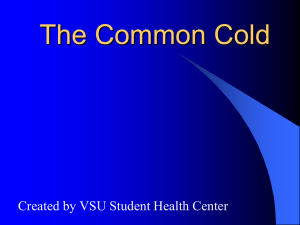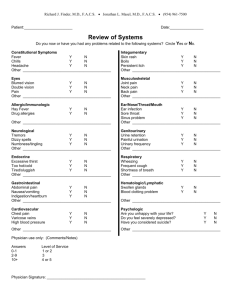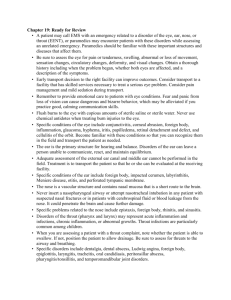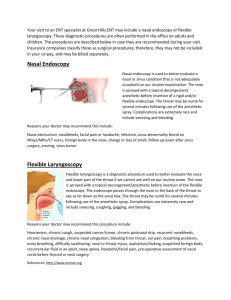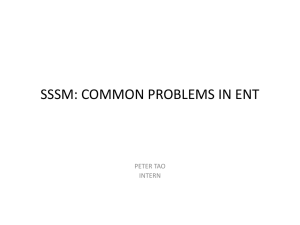PowerPoint Presentation - Croydon Health Services NHS Trust
advertisement
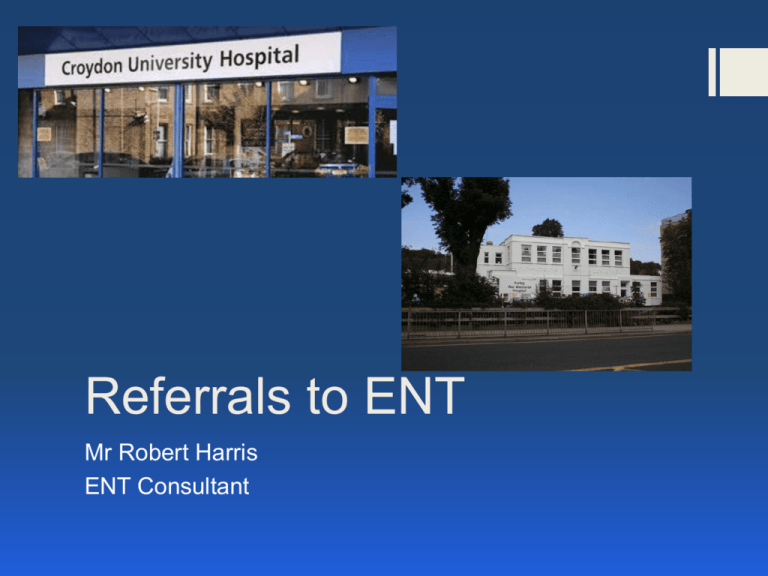
Referrals to ENT Mr Robert Harris ENT Consultant Commonest referrals Adult Hearing Loss / tinnitus Paediatric Glue Ear Paediatric snoring/OSA Adult snoring/OSA Otitis externa Otalgia (cause unknown) Recurrent epistaxis Hoarseness Rhinitis Sinusitis Ear Wax Globus / cough Throat pain Tonsillitis Dizziness Triage options Secondary Care Secondary Care outside Croydon Intermediate Care Back to Referrer Different Specialty Adult Audiology Paediatric Audiology Symptoms in acute and chronic rhinosinusitis ARS Nasal obstruction Anterior or postnasal discharge Progressive severe facial pain (affects teeth if maxillary) Reduced smell not volunteered Often pyrexia CRS Nasal obstruction Anterior or postnasal discharge (often discoloured yellow with eosinophils but green and infected uncommon) Facial pain uncommon unless acute exacerbation Hyposmia common Late onset asthma common Case study – 1 week history of itchy ear 10 Case study – 1 week history of itchy, painful ear, decreased hearing 11 12 13 14 15 ENT UK evidence review and consensus document The following be adopted as formal ENT-UK guidance: When treating a patient with a discharging ear, in whom there is a perforation or patent grommet: 1. If a topical aminoglycoside is used, this should only be in the presence of obvious infection 2. Topical aminoglycosides should be used for no longer than two weeks 3. The justification for using topical aminoglycosides should be explained to the patient https://entuk.org/docs/prof/position_papers/position_paper_ear_drops 16 17 18 19 Case study 65 year old diabetic 3 week history of otalgia 20 Otitis Externa Prevention Keep ears dry Dry thoroughly after wet EarCalm Early intervention with topical steroids / antiobiotics Case study 45 year old IT manager woke yesterday with muffled right hearing 23 Sudden hearing loss Tuning fork tests Consider high dose steroids and urgent referral for intratympanic steroids 24 Paediatric OSA Paediatric OSA Nasal symptoms Snoring Assessment of severity History Video Clinical examination Anterior rhinoscopy Oropharynx Neck Silent Laryngopharyngeal Reflux Excessive throat clearing Persistent cough Hoarseness A "lump" in the throat that doesn't go away with repeated swallowing A sensation of post nasal drip Dry throat Sore throat Hallitosis Furry tongue Silent Laryngopharyngeal Reflux Sleep on an empty stomach Elevate head of bed Smoking cessation PPI double dose with evening meal for 1 month Manage associated anxiety Thank you Mr Robert Harris MSc FRCS NHS CUH T: 02084013327 F: 02084013339 robert.harris@croydonhealth.nhs.u k SGH T: 02087252054 F: 02087253306 robert.harris@stgeorges.nhs.uk Private Shirley Oaks Hospital North Downs Hospital Parkside Hospital T: 02086576653 F: 02086576653 mayhew.karen@googlemail.com Rationale for long-term macrolides for Chronic Rhinosinusitis ARS Stretococcus pneumoniae Haemophilus influenza Moraxella catarrhalis Few anaerobes, streptococci, staphylococcus • CRS Acute RS vs Chronic RS bacteria – Staph Aureus – Coag neg staph – Strep pneum – anaerobes Long-term antibiotics Efficacy of long term treatment in diffuse panbronchiolitis Asian studies CRS over last decade Long-term low-dose macrolide 60-80% improvement in CRS refractory to surgery and steroids Slow onset, ongoing improvement at 4/12 Macrolides Increase mucociliary transport Reduce goblet cell secretion Accelerated apoptosis of neutrophils Other anti-inflammatory effects Inhibit IL expression Reduce virulence and tissue damage caused by chronic bacterial colonisation Increase ciliary beat Long-term macrolides Prospective RCT N=90 CRS =/- NP 3/12 erythromycin ESS VAS, SNOT-22, SF36, NO, rhinometry, saccharine clearance, endoscopy No signif difference in outcome Medical Regimen for Chronic Rhinosinusitis Clarithromycin 250mg bd for 6-12 weeks Xylometazoline bd for 1 week Nasal douche for 6-12 weeks Topical nasal steroids for 6-12 weeks 42 Medical Regimen for nasal polyps Maintenance dose of topical nasal steroid long-term 30mg prednisolone for 7 days as required, (but not more frequently than 3 monthly) 43
